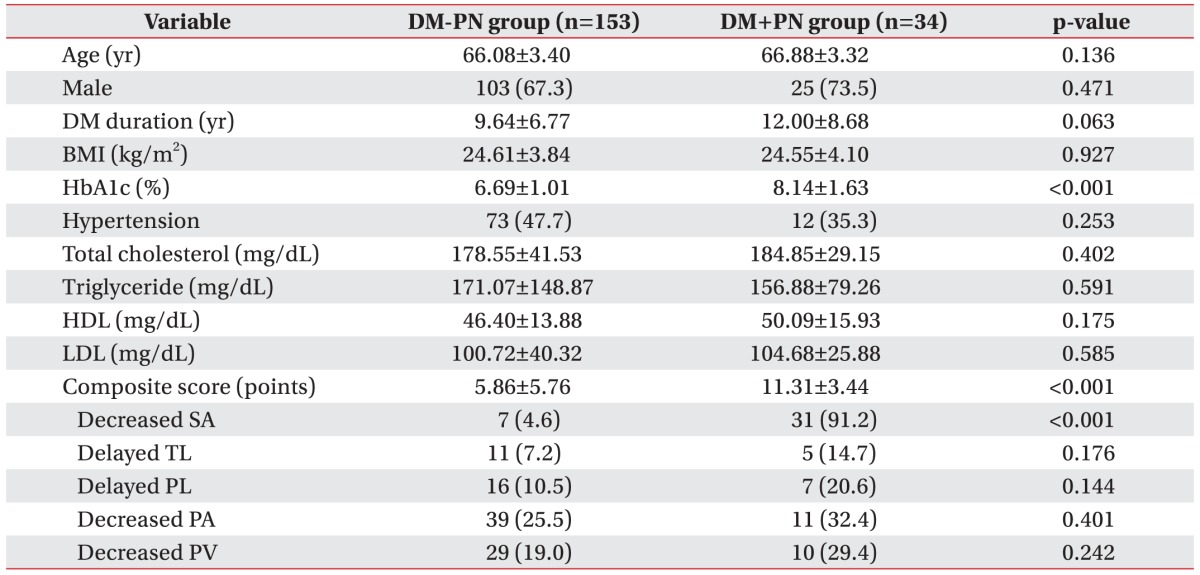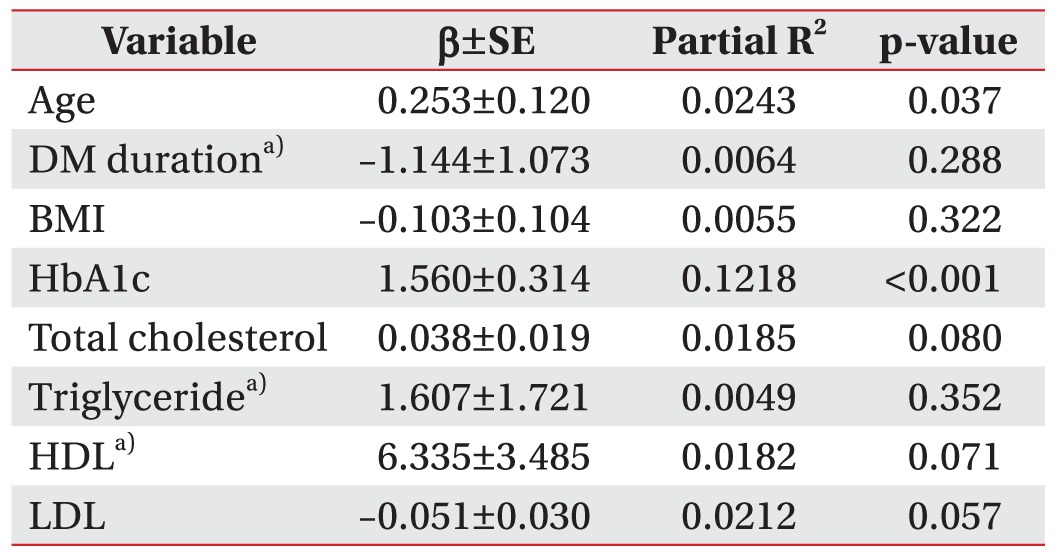1. Gallagher EJ, Leroith D, Karnieli E. The metabolic syndrome: from insulin resistance to obesity and diabetes. Med Clin North Am 2011;95:855-873. PMID:
21855696.


2. Gionfriddo MR, McCoy RG, Lipska KJ. The 2013 American Association of Clinical Endocrinologists' diabetes mellitus management recommendations: improvements needed. JAMA Intern Med 2014;174:179-180. PMID:
24322834.



3. International Expert Committee. International Expert Committee report on the role of the A1C assay in the diagnosis of diabetes. Diabetes Care 2009;32:1327-1334. PMID:
19502545.



4. Deli G, Bosnyak E, Pusch G, Komoly S, Feher G. Diabetic neuropathies: diagnosis and management. Neuroendocrinology 2013;98:267-280. PMID:
24458095.


5. Feng Y, Schlosser FJ, Sumpio BE. The Semmes Weinstein monofilament examination is a significant predictor of the risk of foot ulceration and amputation in patients with diabetes mellitus. J Vasc Surg 2011;53:220-226.e5. PMID:
20692793.


6. Kwon BC, Jung KI, Baek GH. Comparison of sonography and electrodiagnostic testing in the diagnosis of carpal tunnel syndrome. J Hand Surg Am 2008;33:65-71. PMID:
18261667.


7. Mythili A, Kumar KD, Subrahmanyam KA, Venkateswarlu K, Butchi RG. A comparative study of examination scores and quantitative sensory testing in diagnosis of diabetic polyneuropathy. Int J Diabetes Dev Ctries 2010;30:43-48. PMID:
20431806.



8. Dyck PJ, Davies JL, Litchy WJ, O'Brien PC. Longitudinal assessment of diabetic polyneuropathy using a composite score in the Rochester Diabetic Neuropathy Study cohort. Neurology 1997;49:229-239. PMID:
9222195.


9. Dyck PJ, Davies JL, Wilson DM, Service FJ, Melton LJ 3rd, O'Brien PC. Risk factors for severity of diabetic polyneuropathy: intensive longitudinal assessment of the Rochester Diabetic Neuropathy Study cohort. Diabetes Care 1999;22:1479-1486. PMID:
10480512.


10. Shin YS, Kim MO, Kim CH, Nam MS. Relation of nerve conduction study and physical parameters in diabetic polyneuropathy. J Korean Acad Rehabil Med 2009;33:112-117.
11. Dyck PJ, Litchy WJ, Daube JR, Harper CM, Dyck PJ, Davies J, et al. Individual attributes versus composite scores of nerve conduction abnormality: sensitivity, reproducibility, and concordance with impairment. Muscle Nerve 2003;27:202-210. PMID:
12548528.


12. Meijer JW, Smit AJ, Sonderen EV, Groothoff JW, Eisma WH, Links TP. Symptom scoring systems to diagnose distal polyneuropathy in diabetes: the Diabetic Neuropathy Symptom score. Diabet Med 2002;19:962-965. PMID:
12421436.


13. Farooqui AA, Farooqui T, Panza F, Frisardi V. Metabolic syndrome as a risk factor for neurological disorders. Cell Mol Life Sci 2012;69:741-762. PMID:
21997383.


14. Vijan S. Type 2 diabetes. Ann Intern Med 2010;152:ITC3-ITC1.

15. Harttgen K, Kowal P, Strulik H, Chatterji S, Vollmer S. Patterns of frailty in older adults: comparing results from higher and lower income countries using the Survey of Health, Ageing and Retirement in Europe (SHARE) and the Study on Global AGEing and Adult Health (SAGE). PLoS One 2013;8:e75847PMID:
24204581.



16. England JD, Gronseth GS, Franklin G, Miller RG, Asbury AK, Carter GT, et al. Distal symmetric polyneuropathy: a definition for clinical research: report of the American Academy of Neurology, the American Association of Electrodiagnostic Medicine, and the American Academy of Physical Medicine and Rehabilitation. Neurology 2005;64:199-207. PMID:
15668414.


17. Jeong TS, Choi KS, Kim HJ, Park YS. Relations of glycosylated hemoglobin and parameters of nerve conduction study in diabetic peripheral polyneuropathy. J Korean Acad Rehabil Med 2003;27:80-84.
18. Morimoto J, Suzuki Y, Tada A, Akui M, Ozawa Y, Maruyama T. Time-course changes in nerve conduction velocity (NCV) in type 2 diabetes. J Diabetes Complicat 2012;26:237-240. PMID:
22502938.

19. Lee JH, Kim CH, Kim SH, Jeong HJ, Kim MO. Relationship of diabetic polyneuropathy severity with various balance parameters. J Korean Acad Rehabil Med 2010;34:550-553.
20. Strotmeyer ES, de Rekeneire N, Schwartz AV, Faulkner KA, Resnick HE, Goodpaster BH, et al. The relationship of reduced peripheral nerve function and diabetes with physical performance in older white and black adults: the Health, Aging, and Body Composition (Health ABC) study. Diabetes Care 2008;31:1767-1772. PMID:
18535192.



21. Gregg EW, Sorlie P, Paulose-Ram R, Gu Q, Eberhardt MS, Wolz M, et al. Prevalence of lower-extremity disease in the US adult population >=40 years of age with and without diabetes: 1999-2000 national health and nutrition examination survey. Diabetes Care 2004;27:1591-1597. PMID:
15220233.


22. Papanas N, Ziegler D. New diagnostic tests for diabetic distal symmetric polyneuropathy. J Diabetes Complicat 2011;25:44-51. PMID:
19896871.

23. Gallagher EJ, Leroith D, Karnieli E. Insulin resistance in obesity as the underlying cause for the metabolic syndrome. Mt Sinai J Med 2010;77:511-523. PMID:
20960553.


24. Sattar N, McConnachie A, Shaper AG, Blauw GJ, Buckley BM, de Craen AJ, et al. Can metabolic syndrome usefully predict cardiovascular disease and diabetes? Outcome data from two prospective studies. Lancet 2008;371:1927-1935. PMID:
18501419.


25. The ADVANCE Collaborative Group. Intensive blood glucose control and vascular outcomes in patients with type 2 diabetes. N Engl J Med 2008;358:2560-2572. PMID:
18539916.













